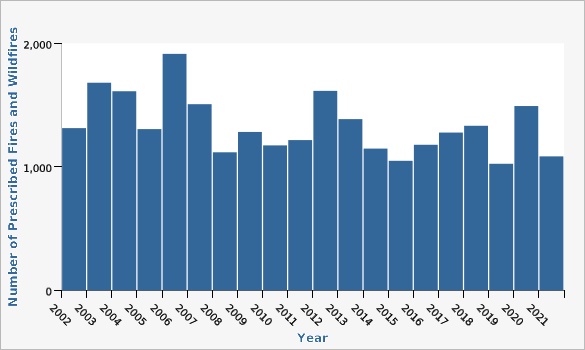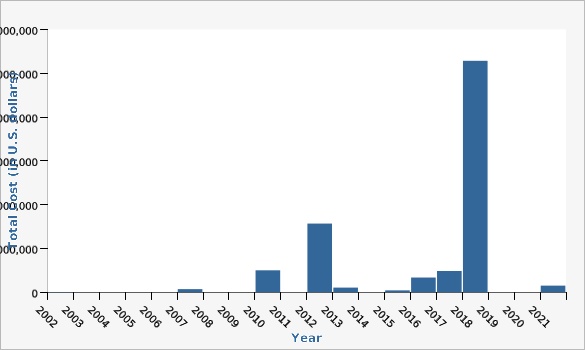Complete Health Indicator Report of Wildland Fires
Definition
__Wildland Fire__[[br]] Any non-structure fire that occurs in vegetation or natural fields [1]. Wildland fire includes prescribed fire and wildfire. [[br]][[br]] __Wildfire__[[br]] Any free burning uncontainable wildland fire not prescribed for the area which consumes the natural fuels and spreads in response to its environment [2]. [[br]][[br]] __Prescribed Fire__[[br]] Any fire intentionally ignited by fire management actions in accordance with applicable laws, policies, and regulations to meet specific objectives [1]. [[br]] [[br]] ---- 1. National Wildfire Coordinating Group (n.d.). Wildland Fire and Incident Management Terminology. Retrieved September 13, 2017 from [https://www.nwcg.gov/glossary/a-z].[[br]] 2. National Oceanic and Atmospheric Association (2009). Glossary - Definition of wildfire. Retrieved December 22, 2016 from [http://w1.weather.gov/glossary/].Numerator
This Indicator Report contains the following variables: # Number of acres burned due to wildfires # Number of acres burned due to prescribed fires # Number of wildfires # Number of prescribed fires # Cost due to wildfire (in U.S. dollars)Denominator
Not applicable.Why Is This Important?
Wildland fires are any non-structure fire that occurs in vegetation or natural fields [1]. Wildland fires include prescribed fire and wildfire. Wildland fires can adversely affect human health, primarily through exposure to smoke. Wildland fire smoke negatively affects everyone, but individuals with pre-existing conditions may have worse symptoms. Common symptoms from smoke inhalation include shortness of breath, chest pain, headaches, coughing, irritated sinuses, and stinging eyes. Vulnerable populations would include those with asthma, heart or lung disease, and other pre-existing respiratory conditions. Individuals with respiratory problems may experience trouble breathing, wheezing, cough, and chest discomfort. Those with heart disease may experience fatigue, rapid heartbeat, chest pain, and shortness of breath. If the fire is severe enough or if there is a high frequency of fires producing an abundance of smoke, even healthy individuals may experience these symptoms [3]. Wildfire frequency is dependent on a delicate balance between precipitation, heat, abundance of fuel (e.g., grass), and natural or human-caused ignition. No one aspect specifically causes a wildfire, but the relationship between these different factors can determine a high- or low-frequency wildfire season. A heavy snowpack in the winter with a wet spring and a slow transition from cool to warm weather could result in a low wildfire season. Consequently, a dry winter, rapid heating in the spring, and an abundance of dry grass could lead to a high-frequency fire season [4]. Although research is limited, it is suspected that climate change could interfere with this multi-factorial balance and potentially alter wildfire frequency. Climate change affects seasonal precipitation and temperature, so it is possible that less precipitation and higher temperatures due to changes in the climate could increase the frequency of wildfires. Prescribed fire is a planned fire; it is also sometimes called a "controlled burn" or "prescribed burn," and is used to meet management objectives [5]. A prescription is a set of conditions that considers the safety of the public and fire staff, weather, and probability of meeting the burn objectives [5]. Prescribed fire is one of the most important tools used to manage fire today. Climate experts project that as the climate continues to change, so will the frequency of extreme weather events. Such events have the potential to adversely affect human health and are therefore a public health concern. Droughts, floods, and wildfires have occurred in Utah, but the question is whether climate change will influence the frequency of these extreme weather events. [[br]][[br]] ---- 1. National Wildfire Coordinating Group (n.d.). Wildland Fire and Incident Management Terminology. Retrieved September 13, 2017 from [https://www.nwcg.gov/glossary/a-z].[[br]] 2. National Oceanic and Atmospheric Association (2009). Glossary - Definition of wildfire. Retrieved December 22, 2016 from [http://w1.weather.gov/glossary/].[[br]] 3. Centers for Disease Control and Prevention (2015). Emergency preparedness and response: Wildfires. Retrieved February 8, 2017 from the Centers for Disease Control and Prevention: [https://www.cdc.gov/disasters/wildfires/smoke.html].[[br]] 4. Dingman, G., Predictive Services, February 15, 2012, personal communication with staff.[[br]] 5. National Park Service (n.d.). Fire Classifications. Retrieved on April 19, 2018 from [https://www.nps.gov/articles/what-is-a-prescribed-fire.htm].What Is Being Done?
Since a variety of agencies handle wildfire response in Utah, public health's role is primarily educational. The CDC has a web page dedicated to how to protect yourself during a fire and what to do after a fire has occurred. How to limit smoke exposure, protecting your home, and treatment for burn victims are some of the topics discussed. Access to wildfire education can be obtained at [https://www.cdc.gov/disasters/wildfires/].Available Services
Up-to-date information about wildfires in Utah can be obtained from the Utah Fire Info website at [https://www.utahfireinfo.gov/]Related Indicators
Related Relevant Population Characteristics Indicators:
Graphical Data Views
Wildland Fires Acreage Burned Due to Wildfires and Prescribed Fires, by Year, Utah, 2002-2021

| Year | Acres | |||||
|---|---|---|---|---|---|---|
Record Count: 20 | ||||||
| 2002 | 272,564 | |||||
| 2003 | 148,721 | |||||
| 2004 | 109,421 | |||||
| 2005 | 342,204 | |||||
| 2006 | 367,446 | |||||
| 2007 | 664,754 | |||||
| 2008 | 66,170 | |||||
| 2009 | 140,926 | |||||
| 2010 | 87,438 | |||||
| 2011 | 79,137 | |||||
| 2012 | 431,699 | |||||
| 2013 | 84,311 | |||||
| 2014 | 44,056 | |||||
| 2015 | 29,234 | |||||
| 2016 | 123,035 | |||||
| 2017 | 268,346 | |||||
| 2018 | 438,983 | |||||
| 2019 | 92,380 | |||||
| 2020 | 329,735 | |||||
| 2021 | 60,863 | |||||
Data Notes
The total number of acreage burned includes wildfires and prescribed fires. The National Park Service states that a "[p]rescribed fire is a planned fire; it is also sometimes called a ?controlled burn? or ?prescribed burn,? and is used to meet management objectives. A prescription is a set of conditions that considers the safety of the public and fire staff, weather, and probability of meeting the burn objectives." [5] [[br]][[br]] ---- 5. National Park Service (March 19, 2020). Wildland Fire: What is a Prescribed Fire?. Retrieved on April 14, 2021 from [https://www.nps.gov/articles/what-is-a-prescribed-fire.htm].Data Source
National Interagency Fire CenterWildland Fires Total Number of Prescribed Fires and Wildfires, by Year, Utah, 2002-2021

| Year | Number of Prescribed Fires and Wildfires | |||||
|---|---|---|---|---|---|---|
Record Count: 20 | ||||||
| 2002 | 1,314 | |||||
| 2003 | 1,682 | |||||
| 2004 | 1,613 | |||||
| 2005 | 1,306 | |||||
| 2006 | 1,916 | |||||
| 2007 | 1,508 | |||||
| 2008 | 1,118 | |||||
| 2009 | 1,283 | |||||
| 2010 | 1,174 | |||||
| 2011 | 1,217 | |||||
| 2012 | 1,616 | |||||
| 2013 | 1,387 | |||||
| 2014 | 1,148 | |||||
| 2015 | 1,049 | |||||
| 2016 | 1,179 | |||||
| 2017 | 1,278 | |||||
| 2018 | 1,333 | |||||
| 2019 | 1,025 | |||||
| 2020 | 1,493 | |||||
| 2021 | 1,085 | |||||
Data Notes
Data for wildland fires includes both prescribed fire and wildfire. The National Park Service states that "Fires customarily are classified as either natural or human-caused. A wildfire is usually started by lightning, lava, or people. Some wildfires ignited naturally may be managed for multiple objectives, which mean they can be monitored, or if management feels it is necessary, contained and extinguished. Prescribed fire is a planned fire and is one of the most important tools used to manage fire today [5]." [[br]] [[br]] ---- 5. National Park Service (n.d.). Fire Classifications. Retrieved on April 19, 2018 from [https://www.nps.gov/articles/what-is-a-prescribed-fire.htm].Data Source
National Interagency Fire CenterWildfires: Damage Cost Due to Wildfires, by Year, Utah, 2002-2021

| Year | Total Cost (in U.S. dollars) | |||||
|---|---|---|---|---|---|---|
Record Count: 20 | ||||||
| 2002 | $50,000 | |||||
| 2003 | $0 | |||||
| 2004 | $0 | |||||
| 2005 | $0 | |||||
| 2006 | $0 | |||||
| 2007 | $700,000 | |||||
| 2008 | $0 | |||||
| 2009 | $0 | |||||
| 2010 | $5,000,000 | |||||
| 2011 | $0 | |||||
| 2012 | $15,675,000 | |||||
| 2013 | $1,050,000 | |||||
| 2014 | $15,000 | |||||
| 2015 | $420,000 | |||||
| 2016 | $3,350,000 | |||||
| 2017 | $4,849,000 | |||||
| 2018 | $52,850,000 | |||||
| 2019 | $0 | |||||
| 2020 | $0 | |||||
| 2021 | $1,500,000 | |||||
Data Notes
The National Park Service states that "Fires customarily are classified as either natural or human-caused. A wildfire is usually started by lightning, lava, or people. Some wildfires ignited naturally may be managed for multiple objectives, which mean they can be monitored, or if management feels it is necessary, contained and extinguished [5]." [[br]] [[br]] ---- 5. National Park Service (n.d.). Fire Classifications. Retrieved on April 19, 2018 from [https://www.nps.gov/articles/what-is-a-prescribed-fire.htm].Data Source
National Oceanic and Atmospheric Administration (NOAA), National Centers for Environmental InformationReferences and Community Resources
__Citations__:[[br]] 1. National Wildfire Coordinating Group (n.d.). Wildland Fire and Incident Management Terminology. Retrieved September 13, 2017 from [https://www.nwcg.gov/glossary/a-z].[[br]] 2. National Oceanic and Atmospheric Association (2009). Glossary - Definition of wildfire. Retrieved December 22, 2016 from [http://w1.weather.gov/glossary/].[[br]] 3. Centers for Disease Control and Prevention (2015). Emergency preparedness and response: Wildfires. Retrieved February 8, 2017 from the Centers for Disease Control and Prevention: [https://www.cdc.gov/disasters/wildfires/smoke.html].[[br]] 4. Dingman, G., Predictive Services, February 15, 2012, personal communication with staff.[[br]] 5. National Park Service (n.d.). Fire Classifications. Retrieved on April 19, 2018 from [https://www.nps.gov/articles/what-is-a-prescribed-fire.htm]. __Resources__:[[br]] To learn more about types of prescribed fires, the benefits of prescribed fires, the history of native Americans using fire to manage ecosystems, and the anatomy of a prescribed burn, visit [http://www.goodfires.org].More Resources and Links
Evidence-based community health improvement ideas and interventions may be found at the following sites:Additional indicator data by state and county may be found on these Websites:
- CDC Prevention Status Reports for all 50 states
- County Health Rankings
- Kaiser Family Foundation's StateHealthFacts.org
- CDC WONDER DATA2010, the Healthy People 2010 Database.
Medical literature can be queried at the PubMed website.
Page Content Updated On 05/20/2022,
Published on 07/07/2022





